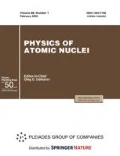Abstract
An analysis of low-energy true ternary (quaternary) nuclear fission leads to the conclusion that these fission modes have a sequential two-step (three-step) character such that the emission of a third particle (third and fourth particles) and the separation of fission fragments occur at distinctly different instants, in contrast to the simultaneous emergence of all fission products in the case of onestep ternary (quaternary) fission. This conclusion relies on the following arguments. First, the emission of a third particle (third and fourth particles) from a fissile nucleus is due to a nonevaporative mechanism associated with a nonadiabatic character of the collective deformation motion of this nucleus at the stages preceding its scission. Second, the axial symmetry of the deformed fissile compound nucleus and the direction of its symmetry axis both remain unchanged at all stages of ternary (quaternary) fission. This circumstancemakes it possible to explain themechanism of the appearance of observed anisotropies and T — odd asymmeries in the angular distributions of products of ternary (quaternary) nuclear fission. Third, the T —odd asymmetry discovered experimentally in ternary nuclear fission induced by cold polarized neutrons obeys the T —invariance condition only in the case of a sequential two-step (three-step) character of true ternary (quaternary) nuclear fission. At the same time, this asymmetry is not a T —invariant quantity in the case of the simultaneous emission of products of true ternary (quaternary) nuclear fission from the fissile compound nucleus.
Similar content being viewed by others
References
I. Halperm, in Proceedings of the Symposium on Physics and Chemistry of Fission (IAEA, Vienna, 1964), p.369.
A. L. Barabanov, Symmetries and Spin–Angular Correlations in Reactions and Decays (Fizmatlit, Moscow, 2010) [in Russian].
N. Carjan, J. Phys. (Paris) 37, 1279 (1976).
O. Tanimura and T. Fliessbach, Z. Phys. A 328, 475 (1987).
S. G. Kadmensky, Phys. At. Nucl. 66, 1691 (2003).
S. G. Kadmensky, Phys. At. Nucl. 67, 170, 241 (2004).
S. G. Kadmensky, Phys. At. Nucl. 71, 1193 (2008).
S. G. Kadmensky, V. E. Bunakov, and L. V. Titova, Phys. At. Nucl. 78, 662 (2015).
M. Mutterer et al., in Proceedings of the 5th International Conference on Dynamical Aspects of Nuclear Fission, Častá-Papiernička, Slovak Republic, 2001 (World Sci., Singapore, 2002), p. 191.
P. Jesinger et al., Eur. Phys. J. A 24, 379 (2005).
S. G. Kadmensky and L. V. Titova, Phys. At. Nucl. 76, 16 (2013).
S. G. Kadmensky, L. V. Titova, and A. O. Bulychev, Phys. At. Nucl. 78, 672 (2015).
A. Bohr and B. R. Mottelson, Nuclear Structure (Benjamin, New York, 1969, 1975), Vols. 1, 2.
J. R. Nix, Nucl. Phys. A 130, 241 (1969).
M. Brack et al., Rev. Mod. Phys. 44, 320 (1972).
P. Fong, Phys. Rev. C 3, 2025 (1971).
V. A. Rubchenya and S. G. Yavshits, Sov. J. Nucl. Phys. 40, 416 (1984).
S. G. Kadmenskiĭ, V. P.Markushev, and V. I. Furman, Sov. J. Nucl. Phys. 35, 166 (1982).
S. G. Kadmenskiĭ, V. P.Markushev, Yu. P. Popov, and V. I. Furman, Sov. J. Nucl. Phys. 39, 4 (1984).
N. Mollenkopf et al., Phys. G. 18, 1203 (1992).
M. Mutterer and J. P. Theobald, Dinuclear Decay Modes (IOP, Bristol, 1996), Chap.12.
M. Ya. Barkovskii et al., Preprint No. 1540, LIYaF (Leningr. Inst. Nucl., Leningrad, 1989).
P. Jesinger, A. Kötzle, A. M. Gagarski, et al., Nucl. Instrum. Methods Phys. Res. A 440, 618 (2000).
A. M. Gagarski, I. S. Guseva, F. Gonnenwein, et al., in Proceedings of the 14th International Seminar on Interaction of Neutrons with Nuclei ISINN-14, Dubna, Russia, May 24–27, 2006 (JINR, Dubna, 2007), p. 93.
V. E. Bunakov and S. G. Kadmensky, Phys. At. Nucl. 66, 1846 (2003).
S. G. Kadmensky and P. V. Kostryukov, Izv. Akad. Nauk, Ser. Fiz. (in press).
S. G. Kadmensky, Phys. At. Nucl. 65, 1785 (2002).
S. G. Kadmensky and O. V. Smolyansky, Bull. Russ. Acad. Sci.: Phys. 71, 336 (2007).
Author information
Authors and Affiliations
Corresponding author
Additional information
Original Russian Text © S.G. Kadmensky, A.O. Bulychev, 2016, published in Yadernaya Fizika, 2016, Vol. 79, No. 5, pp. 564–569.
Rights and permissions
About this article
Cite this article
Kadmensky, S.G., Bulychev, A.O. Sequential character of low-energy ternary and quaternary nuclear fission. Phys. Atom. Nuclei 79, 793–797 (2016). https://doi.org/10.1134/S1063778816050112
Received:
Published:
Issue Date:
DOI: https://doi.org/10.1134/S1063778816050112



